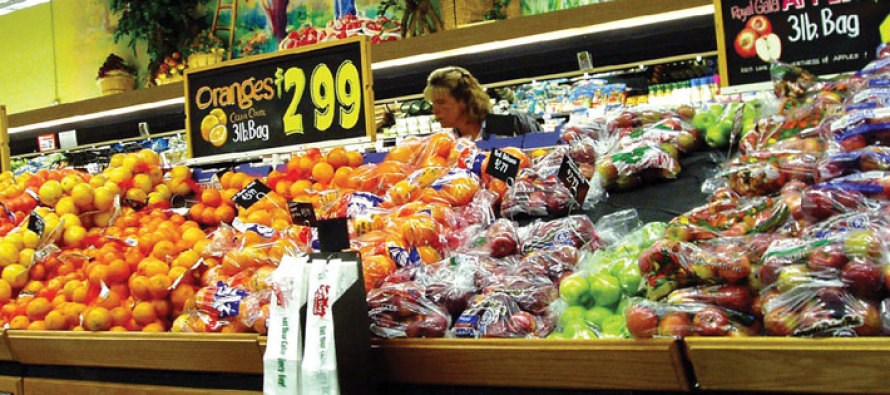Calculated Cuisine

I’m a 24-year-old writer, not trained as a culinary chef. I’ve had experience as a server in the food industry and consider cooking as one of my hobbies.
Since I’ve lived on my own, my favorite activity is finding new recipes to try and I’ve built up quite a library of them. However, as the economy slows I’m starting to feel a squeeze on my money and am struggling to find a balance between healthy ingredients and affordability. I’m that woman you see in the store who is comparing which type of salad dressing has less sodium and fewer calories.My quest is to continue with my hobby of cooking, but to find a way to do it affordably. In each column, I’ll tackle the issue of what’s healthy and what’s affordable when it comes to my favorite products.
The last months of summer mean that my favorite fresh vegetables are in season: tomatoes, bell peppers, corn and cucumbers. However, I’m noticing that it’s getting to be expensive to buy so much fresh produce and, as a single person, I can’t eat everything fast enough before it goes bad. I did some research to find out whether I should buy fresh produce or buy frozen and why when it comes to price and nutrients. This is what I found out.
Growing your own garden
Obviously, the first option is the cheapest and the healthiest. You can purchase seeds to start your own garden or even plants that have been grown in local commercial greenhouses as plants that have been set up in environments like this tend to have the best start when it comes to growing at a significant rate. I found this really helpful article recently about how to grow a garden even if you don’t have space for it. You can plant dwarf and patio versions of plants in galvanized metal tubs and bucket that hold 5 gallons of soil and grow them right on your apartment deck or small back yard. If you’re like me, though, little guys demand a lot more attention than you’re willing to give.
Buying local produce
Community Supported Agriculture (CSA) is a relatively new concept. A local independent farm sells shares to members who then receive a weekly selection of fresh vegetables throughout the growing season. The consumers provide a guaranteed market for the farmers through annual prepaid sales, which also offset the cost of production throughout the year. The idea is gaining momentum because people are seeing the value in keeping small local farms alive despite large corporations who distribute. Joining a CSA is a great way to support the local farming community, and prices are usually competitive with conventionally distributed produce. The blog called 24boxes.blogspot.com is an offbeat look into the consumer side of CSAs, and has inspired ideas for me when cooking fresh produce.
Celeste Lux, of Fertile Ground, a local cooperative of family farms that grow organic produce, told me, “The way food is procured is as important to the end product as how it is prepared. Your local grower is a doorway to so many new culinary discoveries as so much of what is available at your grocery store is grown for transportability and not taste.” Food purchased at a local farmers’ market is guaranteed to be picked for taste because taste is the only way to keep consumers coming back. Local producers pick their produce within a couple of days before selling to the consumer, and because local producers spend less on transportation and sell directly to consumers, prices are usually comparable to store prices. For more information about Farmers’ Markets and CSAs in Nebraska, visit www.buylocalnebraska.org or www.localharvest.org.
Fresh produce from the grocery store
Because produce sold commercially in most grocery stores is picked prior to peak ripeness, it doesn’t have as much time to acquire all of the available vitamins and nutrients as its fellow produce that’s picked later does. These fruits and vegetables will ripen as they sit, but since they’re disconnected from the root system they will not be able to gain additional nutrients. If they are grown in a greenhouse then LED lighting may be used to help them grow (get more information over at scynceled.com to understand the process), this will help them get picked sooner for local stores. Shopping for fresh produce at your local grocer is good when you need a last-minute ingredient, but for nutritional and taste factors, you can’t beat local produce.
Frozen produce from the grocery store
Frozen vegetables are frozen right at the point of ripeness ensuring that the full spectrum of vitamins and minerals is present. The produce is first blanched in hot water or steam to kill bacteria and then frozen. During this process all but the water soluble nutrients are preserved. Water-soluble nutrients are usually Vitamins B and C. This option is also good for when you’re in a pinch, and it’s the only solution when you’re craving something that is unfortunately not in season. Frozen produce tends to run about double the price of fresh produce in the grocery store.
While price is important, taste, nutritional value and the chance to support my local community are all, to me anyway more important; especially since the price difference appears to be nominal. Until next time.
No comments
Write a commentOnly registered users can comment.











